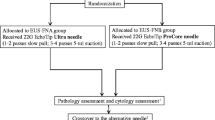PURPOSE: There is scant data about the clinical impact of endoscopic ultrasound-guided fine-needle aspiration in rectal carcinoma. This study was designed to determine the impact of endoscopic ultrasound-guided fine-needle aspiration on the staging and management of rectal carcinoma and to compare the staging accuracy of computed tomography scan, endoscopic ultrasound, and endoscopic ultrasound-guided fine-needle aspiration. METHODS: The records of 60 consecutive patients diagnosed with rectal carcinoma referred for endoscopic ultrasound staging were reviewed. Computed tomography scans, endoscopic ultrasound imaging, endoscopic ultrasound-guided fine-needle aspiration staging, surgical pathology, and subsequent treatment were compared. RESULTS: Of 48 patients who underwent computed tomography scan imaging, the additional information provided by endoscopic ultrasound changed management in 38 percent of patients. Sixteen patients identified as having nonjuxtatumoral lymph nodes underwent fine-needle aspiration and the additional information obtained changed therapy in three (19 percent) of these patients. All five cases of recurrent rectal carcinoma were correctly diagnosed by fine-needle aspiration. Tumor staging accuracy was 45 percent (computed tomography) and 89 percent (endoscopic ultrasound; P < 0.0001); nodal staging accuracy was 68 percent (computed tomography), 85 percent (endoscopic ultrasound), and 92 percent (endoscopic ultrasound-guided fine-needle aspiration; P = not significant). CONCLUSIONS: Endoscopic ultrasound imaging was better than computed tomography scanning at overall tumor staging, whereas endoscopic ultrasound-guided fine-needle aspiration demonstrated a trend toward more accurate nodal staging. Preoperative staging with endoscopic ultrasound resulted in a change of management in 38 percent of patients. The addition of fine-needle aspiration changed the management in 19 percent of those who underwent nonjuxtatumoral lymph node sampling. Endoscopic ultrasound-guided fine-needle aspiration accurately diagnosed 100 percent of those with recurrent rectal carcinoma. Clearly, endoscopic ultrasound and endoscopic ultrasound-guided fine-needle aspiration are important for the staging and management of rectal carcinoma and for detecting disease recurrence.
Similar content being viewed by others
Author information
Authors and Affiliations
Corresponding author
About this article
Cite this article
Shami, V., Parmar, K. & Waxman, I. Clinical Impact of Endoscopic Ultrasound and Endoscopic Ultrasound-Guided Fine-Needle Aspiration in the Management of Rectal Carcinoma. Dis Colon Rect 47, 59–65 (2004). https://doi.org/10.1007/s10350-003-0001-1
Published:
Issue Date:
DOI: https://doi.org/10.1007/s10350-003-0001-1




